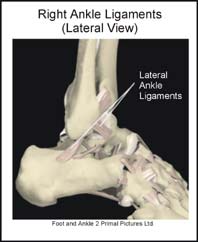In order to understand this condition, it is important to understand the anatomy and function of the foot and ankle. Please read Foot Pain Info ‘s section on basic foot anatomy and Ankle Pain Info’s section on basic ankle anatomy. For additional background information on the biomechanics of the foot please read Foot Pain Info’s section on basic foot and ankle biomechanics.

What is an ankle sprain?
The bones of the ankle are stabilized by rope-like structures called ligaments. There are four main ligaments around the ankle. One group of three ligaments is located on the outer (lateral) side of the ankle. It is called the lateral ligament complex. The other ligament is located on the inner (medial) side of the ankle. It is a thick ligament called the deltoid ligament. An ankle sprain is a stretching or tearing of these ligaments. Ankle sprains are relatively common, and lateral ankle sprains are more common than medial ankle sprains.
How do ankle sprains occur?
Ankle sprains are caused by excessive inward or outward movements of the foot past it’s normal range of motion. If the ligaments cannot withstand the force, they will stretch or tear. These movements usually occur when landing after a jump, or when rapidly changing direction while running. Lateral ankle sprains occur when the lower leg rolls over to the ankle to the lateral side, forcing the bottom of the foot to face inwards toward the body. This is called an inversion injury. Medial ankle sprains occur when the lower leg rolls over the ankle to the medial side, forcing the bottom of the foot to face outward, away from the body. This is called an eversion injury.
What does an ankle sprain feel like?
At the time of the injury, there may be a cracking or tearing sound. Mild to severe pain usually follows rapidly, followed by swelling and, in severe cases, inability to weight-bear. Often there is discoloration or bruising around the injured area. The ability to move the ankle through its normal range of motion may be limited by swelling and pain. When these ligaments are stretched or torn, the ankle may become unstable, and movement of the ankle joint becomes less controlled.
How are ankle sprains detected?
The assessment of an ankle sprain requires an accurate determination of the events that surrounded the injury and a physical examination of the injured ankle, including special tests of the ligaments. In more severe cases where swelling is excessive, the injured ankle may need to be evaluated again at a later date in order to adequately assess the integrity of the ankle ligaments. Ankle sprains may be classified into one of three categories: Grade 1, Grade 2, and Grade 3. Grade 1 ankle sprains involve stretching of the ankle ligaments. Grade 2 ankle sprains involve stretching and partial tearing of the ligaments. Finally, Grade 3 ankle sprains, the most severe, involve complete tearing of the ligaments.
Table of Tissue Healing Timelines

Harrygouvas at the Greek language Wikipedia, CC BY-SA 3.0 http://creativecommons.org/licenses/by-sa/3.0/, via Wikimedia Commons
Can an ankle sprain be detected on X-rays?
Damage to the ankle ligaments cannot be seen on x-rays. However, x-rays may be required to ensure that a fracture (broken bone) has not occurred. Other diagnostic tests, such as bone scans, CT scans or MRI’s, are not usually required in the majority of ankle sprains.
How are ankle sprains treated?
The treatment of an ankle sprain depends on the severity of the injury. Each treatment plan should be individualized. Initially, protection (by use of crutches and/or an ankle brace), rest, ice, compression and elevation (PRICE) of the injured ankle will help reduce pain and/or swelling. Medications may also be required to help reduce pain and swelling. The time it takes for the damaged tissues to heal depends on the severity of the injury.
View a table of tissue healing times.
After an ankle sprain, the long-term goal is to return the individual back to their previous level of activity. Achieving this goal will depend on the function and stability of the ankle. A general rehabilitation program, which includes strengthening exercises, flexibility exercises, aerobic conditioning, technique refinement and proprioceptive (biofeedback) retraining is the most important factor in improving ankle function and stability. Stability may be improved by an ankle brace. Rarely, surgery is required.
What other information is available on ankle sprains?
Foot Pain Info’s links section has additional information on this topic. Links have been provided to other websites as well as online medical journals. Visit Joint Pain Info for information on other joint injuries and problems.
